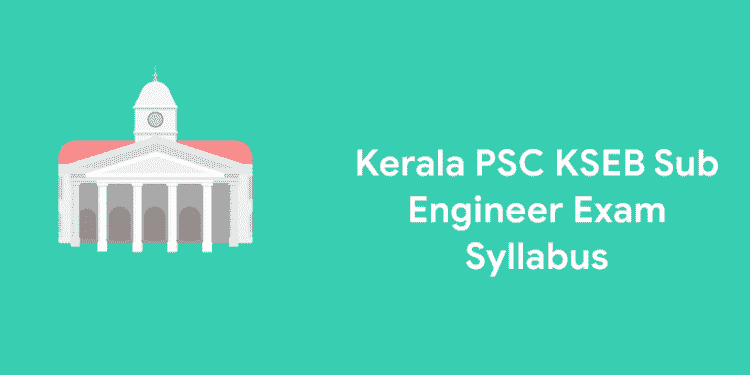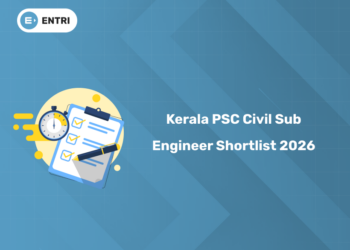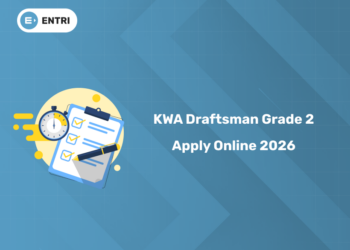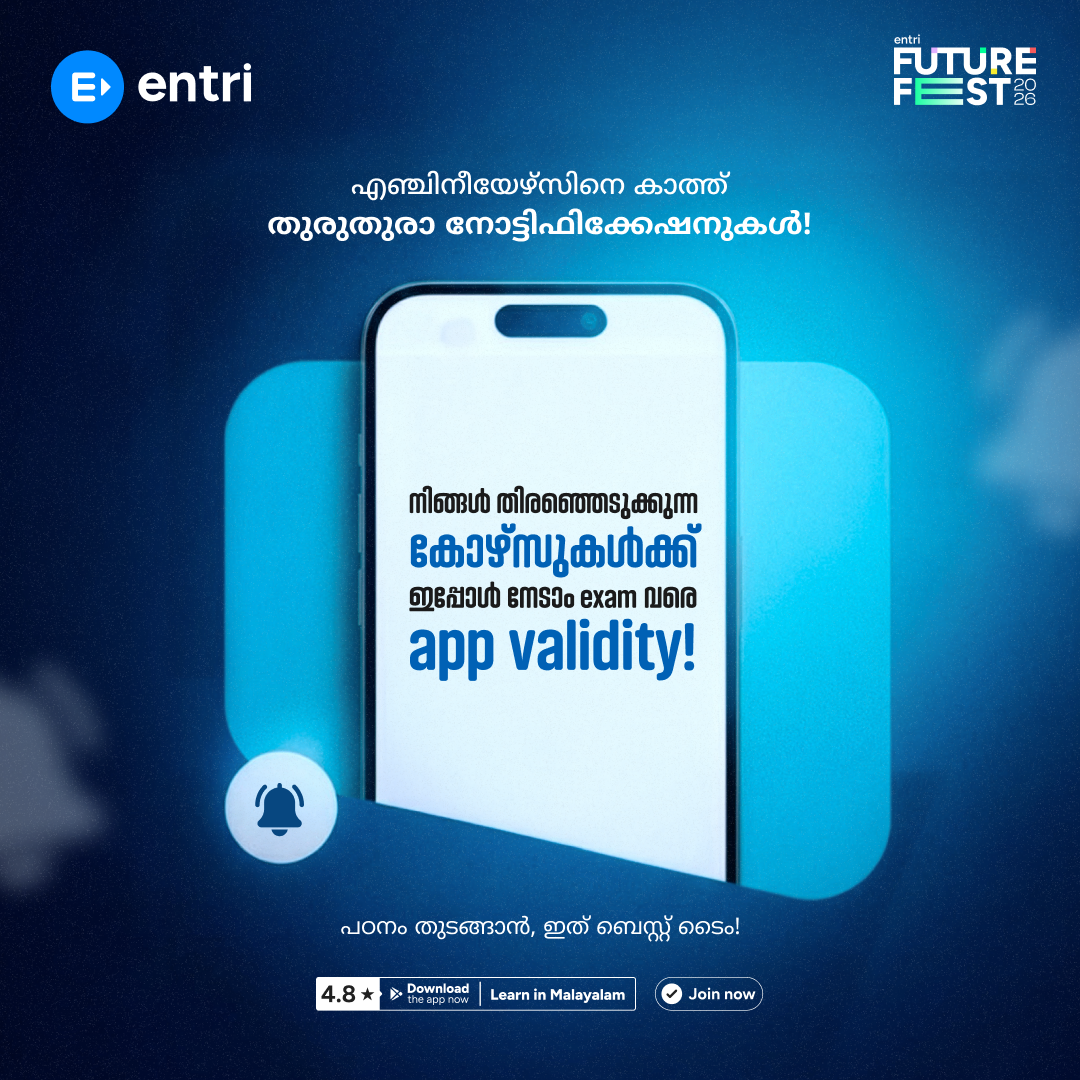Table of Contents
Are you a student looking to apply for the KSEB Sub Engineer Civil position in 2023? If so, you must be aware of the syllabus released by the Kerala State Electricity Board. We are pleased to inform you that the KSEB Sub Engineer Civil Syllabus 2023 has been released, offering a comprehensive guide to the selection process. This syllabus provides a comprehensive overview of the topics to be covered, the exam pattern, and the marking scheme. With this syllabus in hand, you can now confidently prepare for the KSEB Sub Engineer Civil exam and ace it with ease.
Attempt free Kerala Technical PSC Mock Tests! Download Entri App!
KSEB Sub Engineer Civil Syllabus 2023: Overview
| Particulars | Details |
| Organization Name | Kerala PSC |
| Department | Kerala State Electricity Board |
| Post name | Sub Engineer |
| Exam mode | OMR/ Online/Written |
| Selection procedure | Examination and Personal interview |
| Official website | www.keralapsc.gov.in |
Kerala PSC Sub Engineer Civil Recruitment 2023: Apply Date
1: Between the period of 1858-1947, how many Viceroys ruled over India?
- The Kerala PSC Application Process commenced on October 01, 2023
- The registration window is available at keralapsc.gov.in
- Eligibile candidates can apply through the website on or before last date to apply
- No application will be considered after the specified time/date
- Candidates need to generate a User Id and Password to log in to the online form.
- Remember to add all the personal info and accadamic details accurately in the online form
- Do not forget to double check the details on the Sub Engineer Civil Online Form before final submission
Prepare for Kerala PSC Technical Exams with Entri
സർക്കാർ ജോലി എന്ന സ്വപ്നം ഇനി സ്വപ്നം മാത്രമല്ല! Join Kerala's Top-rated PSC Coaching Programs
Join NowKerala PSC KSEB Sub Engineer Exam Date 2023
The KSEB Sub Engineer Exam Date 2023 will be conducted on July 12, 2023. Candidates who have applied for the vacancy and have fulfilled all the eligibility criteria set by the Commission will be qualified to attend the exam. The written exam will be of OMR pattern. Candidates who have applied for the post of KSEB Sub Engineer can now download their Admit Cards from the official website of Kerala PSC till July 12, 2023. It will made available from June 27, 2023. Candidates need to take a print out of the Admit Card and carry it along with them for the exam. You can use your login credentials to download KSEB Sub Engineer Hall Ticket 2023.
Kerala PSC Sub Engineer Civil Recruitment 2023 – Important Dates
Candidates interested in applying for Sub Engineer Vacancy 2023 should keep in mind the important dates for the selection process listed below:
| Event | Date |
| Commencement of online application | October 01, 2023 |
| Last date for online application | November 02, 2023 |
| Admit Card | June 27, 2023 |
| Exam date | July 12, 2023 |
| Result declaration | Yet to be announced |
Kerala PSC KSEB Sub Engineer Civil Recruitment 2023: Eligibility Criteria
For the candidates to make an application for the Kerala PSC KSEB Sub Engineer recruitment 2021 they have to meet certain eligibility criteria. Here are the details regarding the eligibility criteria’s that candidates have to meet so as to apply for the posts.
KSEB Sub Engineer Civil Age Limit
Minimum Age: 18 Years
Maximum Age: 37 Years
KSEB Sub Engineer Civil Educational Qualification
Diploma in Civil or Mechanical Engineering of the Kerala University or equivalent thereto
OR
Licentiate in Civil or Mechanical Engineering from the Technical Institute at Kozhikode , Kalamassery, Thrissur or other equivalent course
OR
Upper or Lower Subordinate Diploma of College of Engineering, Guindy
OR
Group Certificate (KGTE or MGTE)
Note : – Group Certificate will include all four groups viz.
1. Building Drawing
2. Building Construction
3. Survey and
4. Irrigation
Alternatively a pass in eight subjects viz.,
1. Surveying and Levelling (Higher)
2. Applied Mechanics (Higher)
3. Building Materials and Construction (Higher)
4. Building, Drawing and Estimating (Higher)
5. Earth Work and Road Making (Higher)
6. Hydraulics and Irrigation(Higher)
7. Geomatrical Drawing (Lower)
8. Mensuration (Lower)
OR
(e) Craftsman Certificate from Industrial Training Centre as Draftsman (Civil) or Draftsman (Mechanical) or Survey Trade Test with five years service under the Board.
OR
(f) KGCE in Civil Engineering.
Candidates shall appear in person for verification of the original documents on the date, time, and venue allotted by the Commission, at their own expense.
Prepare for Kerala PSC Technical Exams with Entri
സർക്കാർ ജോലി എന്ന സ്വപ്നം ഇനി സ്വപ്നം മാത്രമല്ല! Join Kerala's Top-rated PSC Coaching Programs
Join NowKerala PSC KSEB Sub Engineer Civil Vacancy 2023
There are 15 vacancies are announced. The details regarding Kerala PSC Sub Engineer Civil Vacancy 2023 has listed in the official Notification. If interested check the PDF given below
KSEB Sub Engineer Exam Pattern 2023
Name of the Subjects
Number of Marks
PART I
50 Marks
PART II
50 Marks
KSEB Sub Engineer Civil Syllabus 2023
PART 1 MECHANICAL
Module 1: Engineering Graphics with units of measurement, scales, enlarging scale, reducing scale, and full scale. Plain scale, diagonal scale, and vernier scale. Units and their conversions. Size of drawing sheets and drawing boards and various other drawing instruments, Conic sections, miscellaneous scales, construction of polygons, orthographic projection, Isometric projection, development of surface, a section of solids, developments of surfaces, Auto CAD, various commands.
Module 2: Engineering Mechanics: Forces, different types of forces, a system of forces, magnitude, direction, and position of the resultant of a system of forces, moments, couples, different types of friction, laws of friction, limiting friction, normal reaction, cone of friction, coefficient of friction, angle of friction, angle of repose, frames, Perfect frames, imperfect frames, method of section and method of the joint to find forces in each member. Centre of gravity, centroid, moment of inertia, parallel axis and perpendicular axis theorem, radius of gyration, moment of inertia, and center of gravity of common figures.
Module 3: Strength of Materials: stress, strain, elastic constants, thermal stress, and strains, composite beams, the relation between various elastic constants, beams, types of beams, types of loads, shear force and bending moment, shear force bending moment diagrams of simply supported, cantilever and overhanging beam, point of contra flexure. Columns and struts, different end conditions of columns, assumptions of column theory, Euler’s formula and Rankine formula, limitations of Euler’s formula, slenderness ratio, short column, long column, medium column based on slenderness ratio, welded and riveted joints and their strength and efficiencies, Dams and retaining walls
Module 4: Fluid Mechanics: Fluid, types of fluids, properties of fluids, Pascal’s law, hydrostatic law, atmospheric pressure, absolute pressure, manometer, simple manometers U tube and differential u tube manometer, pressure gauges, piezometer tube, valves and gates, Buoyancy, the center of buoyance, the center of pressure, pressure diagram, Meta center, and Metacentric height, Bernoulli’s theorem, assumption and application of Bernoulli’s theorem, Venturi meter, orifice meter, Pitot tube, notches, and weirs, discharge through notches and weirs, dimensional analysis, Buckingham Pi theorem, Dimensionless numbers, its ratios, Boundary layer theory, and various boundary layers.
Module 5: Hydraulic Machines: Hydraulic machines, classifications, Impact of jet, jet propulsion, Hydraulic turbines, Impulse, and reaction turbines, specific speed, classification of turbines based on specific speed, governing of turbines, draft tube, different types draft tubes, Pumps various types of positive and rotodynamic pumps, specific speed of pumps, water hammer, vapor pressure, and cavitations.
Module 6: Thermal and Thermodynamics: Thermodynamics system, continuum concept, various thermodynamic systems, first, second, and third of thermodynamics, Energy balance equation, and its application in nozzle, pumps, and turbines, Various cycles by which thermal power plant and Gas turbine power plants working, Internal combustion engines and External Combustion engines, Carnot cycle, Otto cycle, Diesel cycle, P-v, and T-s diagrams and its importance, solar power, tidal power geothermal power and windmills
PART 1 CIVIL
MODULE I-SURVEYING
Purpose of surveying – types of survey -Levelling -Principle of leveling – parts and functions of dumpy level and telescopic leveling staff steps involved in performing the temporary adjustments of leveling Instrument-record observations in field book – compute the reduced levels of stations from the field book – Classifications of leveling- steps involved in the classification of leveling – the principle of contouring – contour plans from given field notes. Theodolite traversing- Principles of theodolite traversing – their parts and function –temporary adjustments and terms-fundamental lines and their relationship-horizontal angle measurement by repetition and reiteration method -steps involved in setting out angles using a theodolite – method of conducting traverse survey in the field using the theodolite – compute the co-ordinates-principle of trigonometry for determining the elevation of stations-vertical angle measurements-principle of trigonometric leveling-compute the elevations using trigonometric leveling.
CURVES– different types – elements of a simple curve – designation of a curve – setting out simple curves by offset method – from a long chord, long tangents, chord produced. description of transition curves. Requirement of transition curves – length of transition curves for roads – introduction to vertical curves – geometrics of a vertical curve.
Modern surveying equipment-TOTAL STATIONS, GPS AND GIS, Electronic Theodolites – Total stations – component parts –set up– working principles – maintenance of EDM instruments –temporary adjustments –measurement with a total station, traverse with a total station, Survey station description-data gathering components-data processing components- error sources and controlling errors-field coding-field controlling-Modem for data transfer- readings with prism mode and non prism mode. Remote sensing – Introduction and applications in Civil Engineering. Global positioning system (GPS) – fundamentals, GPS receivers, GPS observations, a transformation of GPS results.
Geographical information systems (GIS) – map definitions, map projections data entry importance, use, and application of GIS in Civil Engineering.Introduction to Photogrammetry, aerial, and terrestrial, applications of photogrammetry.
MODULE II – BUILDING PLANNING AND DRAWING
Building drawing – Conventional signs for construction materials- Building rules and Bye-laws- Provision of safety for buildings, plinth area-floor area-carpet area-floor area ratio-coverage of building-height of building, building line-set back line-head room-mezzanine floor- basement floor- detached building–row houses. Classification of Buildings and Planning requirements of building as per National Building Code/ KMBR/ KPBR. Plumbing layout showing water supply and sanitary fixtures of a residential building-electrical layout showing electrical fixtures and control points.
MODULE III-CONSTRUCTION MATERIALS AND ENGINEERING
Broad classification of materials – Natural, Artificial, special, finished, and recycled. – Requirements of good building stone – general characteristics of stone – Laterite stones quarrying and dressing of stone – Structure of timber, general properties and uses of good timber – different methods of seasoning for the preservation of timber – defects in timber – use of bamboo in construction. Lime – Properties – types, and uses – Types of soil and its suitability in construction. Constituents of brick earthManufacturing process of burnt clay brick, fly ash bricks, Autoclave Aerated Concrete (AAC) blocks – Conventional / Traditional bricks – Modular and Standard bricks, Special bricks – fly ash bricks, Characteristics of good brick, Field tests on Bricks -Classification of burnt clay bricks and their suitability.
Flooring materials: Types, uses (Natural and Artificial) – Granite, Marble, Clay tiles, Ceramic tiles etc. Pavement blocks and their uses. – Wood products: Plywood, particle board, Veneers, laminated board, and their uses. – Types of glass: soda lime glass, lead glass, Toughened glass, and borosilicate glass and their uses. – Ferrous and nonferrous metals and their uses – Types of material and suitability in construction works of following materials – Waterproofing, Termite proofing; Thermal and sound insulating materials – Constituents and uses of POP (Plaster of Paris), POP finishing boards, sizes and uses – Paints- whitewash, cement paint, Distempers, Oil Paints and Varnishes with their uses. (Situations where used) – Industrial waste materials- Fly ash, Blast furnace slag – Agro waste materials – Rice husk, Bagasse, coir fibers, and their uses – Special processed construction materials- Ferro Crete, Artificial timber, MDF, HDF, PVC foam board, WPC, ACP, Artificial sand (M sand) and their uses. Structural Steel sections for buildings.
Types of Constructions – Load Bearing wall Structure, Framed Structure, Composite Structure, Prefabricated structures, Special framed structure for earthquake resistance (IS 13920) – Construction methods for Structural Steel buildings. Building Components – Functions of Building Components – Substructure – Foundation – Plinth.- DPC – Superstructure – Parts of the building – Walls, Partition wall, and Cavity wall, Sill, Lintel, Doors and Windows, Floor, etc. Construction of Substructure – Job Layout – Site Clearance, Layout for Load Bearing Structure and Framed Structure by Center Line and Face Line Method. Earthwork: Excavation for Foundation – Timbering and Strutting – Materials used for plinth Filling – Foundation – Functions of foundation – Types of foundation – Shallow Foundation and Deep Foundation – Stepped Footing, Wall Footing, Column Footing, Isolated and Combined Column Footing, Raft Foundation, Grillage Foundation, Strap footing, Pile Foundation, Well foundation, and Caissons.
Types of stone masonry – Rubble masonry, Ashlar Masonry. – Pointing of stone masonry and their purpose – Precautions. Brick masonry – Terms used in brick masonry-Bonds in brick masonry- header bond, stretcher bond, English bond, Flemish bond, etc. Requirements of Brick Masonry – Precautions to be observed – Hollow and Solid concrete block masonry – composite masonry – interlock bricks. Scaffolding and Shoring – Purpose and Types – Underpinning – Formwork. Doors – Fully Paneled Doors, Partly Paneled and Glazed Doors, Flush Doors, Collapsible Doors, Rolling Shutters, Revolving Doors, Glazed Doors. Windows: Fully Paneled, Partly Paneled, and Glazed, wooden, Steel, Aluminium windows, Sliding Windows, Louvered Windows, Bay windows, Corner windows, Gable and Dormer windows, Skylight – Sizes of Windows recommended by BIS. Ventilators – Fixtures and fastenings for doors and windows.
Vertical Communication methods-stair, lifts, and escalators. Roofs – Roofing Materials – RCC, MP Tiles, Ceramic roofing tiles, Thatched, G.I. sheets, Corrugated G.I. Sheets, Plastic and Fiber Sheets, Innovative roofing materials (Fiber reinforced cement board, Shingles etc.), Types of Roof – Flat roof, Pitched Roof – terms used in roofs – King Post truss, Queen Post Truss-terms used.
MODULE IV- CONCRETE TECHNOLOGY
Ingredients of cement, Manufacturing of cement- dry process, wet process, Hydration of cement, Types of cement, Physical properties of OPC & blended cement – fineness, standard consistency, setting time, soundness, compressive strength-Different grades of OPC and relevant BIS codes – Testing of cement: Laboratory tests-fineness, standard consistency, setting time, soundness, compressive strength – Storage of cement and effect of storage on properties of cement – BIS Specifications and field applications of different types of cement: Rapid hardening, Low heat, Portland pozzolana, Sulphate resisting, Blast furnace slag, High Alumina, and White Cement –
Aggregates: Requirements of good aggregate-Classification according to size and shape-Fine aggregates: Properties, size, specific gravity, bulk density, water absorption and bulking, fineness modulus and grading zone of sand-silt content and their specification as per IS 383 – Concept of crushed Sand – Coarse aggregates: Properties, size, shape, surface texture, water absorption, soundness, specific gravity and bulk density, fineness modulus of coarse aggregate- grading of coarse aggregates – crushing value, impact value and abrasion value of coarse aggregates with specifications – Water: Quality of water, impurities in water and permissible limits for solids.
Properties of ingredients of concrete, Properties of Fresh and Hardened Concrete Concrete: Different grades of concrete, nominal and design mix, provisions of IS 456 – Duff Abrams’ water-cement (w/c) ratio law -the significance of w/c ratio – range of w/c ratio for different grades – maximum w/c ratio for different grades of concrete for different exposure conditions as per IS 456. Workability – Factors affecting the workability of concrete. Determination of workability of concrete by slump cone, compaction factor, Vee-Bee Consistometer- workability requirement for different types of concrete works – Segregation- bleeding and preventive measures – Properties of Hardened Concrete: Strength, Durability, Impermeability – Concreting Operations: Batching, Mixing, Transportation, Placing, Compaction, Curing and finishing of concrete – Joints in concrete construction – Types of joints – methods for joining old and new concrete – materials used for filling joints. Chemical Admixture, Special Concrete, and Extreme Weather concreting Admixtures in concrete – Purpose, properties, and application for different types of admixture – accelerating admixtures – retarding admixtures – water reducing admixtures – air entraining admixtures and superplasticizers- Special Concrete – Properties, advantages and limitation of different types of Special concrete – Ready mix Concrete – Fiber Reinforced Concrete – High-performance Concrete – Self-compacting concrete – lightweight concrete, Geopolymer concrete- Mass concrete – Cold weather concreting – effect of cold weather on concrete – precautions to be taken while concreting in cold weather condition – Hot weather concreting – effect of hot weather on concrete – precautions to be taken while concreting in hot weather condition. Underwater concretingConcrete exposed to seawater.
Testing of concrete -determination of compressive strength of concrete cubes at different ages – Nondestructive testing of concrete: Importance of NDT tests – Rebound hammer test – working principle of rebound hammer – factors affecting the rebound index – Ultrasonic pulse velocity test as per IS 13311 (Part 1 & 2) – waterproofing: Importance and need of waterproofing – methods of waterproofing – materials used for waterproofing
Prepare for Civil Engineering PSC Exams! Get free demo video!
IRRIGATION ENGINEERING
Irrigation and its classification. Crop Water requirement: Cropping seasons, Cropping Calendar (Kerala), Crop period, base period, Duty, Delta, Command area, the intensity of irrigation, and factors affecting duty. Irrigation structures- classification of head works– storage and diversion head works – their suitability under different conditions. Storage Headworks: Dams and their classification: Earthen dams and Gravity dams (Masonry concrete). Earthen Dams and spillways – Components with function, typical cross-section. Gravity dams – typical cross-section, drainage gallery. Spillways – Definition, function, location, Energy dissipaters. Diversion head works – Layout, components, and their function. Weirs – Components, parts, types Barragescomponents and their functions. Difference between Weir and Barrage. Canal regulators – Head regulator, Cross regulator, Escape, Falls, and Outlets (Brief description only) Cross Drainage works – Aqueduct, siphon aqueduct, super passage, level crossing (Brief description only)
MODULE V- STRUCTURAL DESIGN
The concept of Limit State Design, Partial Safety factors in the Limit State method of Design, values of Partial safety factors as per BIS, Principles of Limit State Design, Characteristic load & characteristic strength, stress-strain curve of Concrete and steel, assumptions made in the Limit State method of Design, Depth of neutral axis, Lever arm-Moment of resistance. Type of sections – Limiting value of NA and Limiting moment of resistance. Design a singly reinforced rectangular simply supported beam and Cantilever beams for different loading conditions for flexure, (also using SP 16). Design doubly Reinforced Rectangular beams under different loading conditions. Design of lintels under different loading conditions.
Design of flanged beams under different loading conditions, Check for stiffness as per IS 456-2000, Basic l/d ratio, Modification factor, reduction factor for flanged beams, Check the deflection of singly reinforced, doubly reinforced, and flanged beams, the shear and torsion behavior in RCC members, Nominal shear stress, maximum shear stress in concrete, and permissible shear stress in concrete. Design beams under different loading Conditions for shear, bond, and anchorage, calculation of development length, Check for curtailment of bars in beams, Code provisions for lap length
Study the behavior of slabs, Design of one-way slabs – simply supported – Continuous– cantilever. Design of sunshade. Design of Two-way slab – simply supported – restrained and different end conditions.
Design of staircases under different loading and end conditions – dog-legged and open well. Theory on the design of columns – the behavior of short and long columns – Slenderness limit for columns as per IS code. Design the short column for direct load – Design the column for uniaxial bending using SP16, Study of slender columns. Theory of Column footing – isolated and combined. Design of isolated column footing – square and rectangular.
MODULE VI– QUANTITY SURVEYING
Quantity surveying-quantity surveyor– duties of quantity surveyor-essential requirements of a quantity surveyor, Different types of estimates, approximate estimate-types of the approximate estimate, Unit of measurements for different items as per standard, sundries, Lump sum, Lead and lift, contingencies unforeseen items work charged establishment. The capacity of the reservoir from a contour map. Different methods of taking out quantities, method Compute quantities of a compound wall – steps – doors-windows-ventilator. Cost of materials at source and at the site–conveyance charges–standard data book, schedule of rates – Lump sum items –-extra labor – contractor’s profit- conveyance statement for different materials-– schedule of rates labor and materials -Analysis of rates-preparation of standard DATA of CPWD with specification as per CPWD standard- Rules of measurements – rules regarding tolerance of wastage of materials- general rules for taking measurements as per CPWD standard-abstract of the estimate- preparation of abstract
Detailed Estimate of RCC beam, slab, Column, and preparation of bar bending schedule. Detailed Estimate of Aqueduct. Detailed specifications for various items of work of Earth work excavation, Foundation concrete, Masonry work, D P C, Formwork, RCC, Plastering, Pointing, Flooring, Painting and polishing, I RC Specifications for WBM road. Preparation of Plan, Estimate, and other documents for submission. Valuation- Definition of Valuation: – Purpose-Factors governing valuation-Life of structure-type, location Maintenance -legal control. Scrap value-salvage value-market value-book value-sinking fund annuity and depreciation.Methods of valuation: -Rental method-direct comparison with cost-Based on profit- Development method of valuation-depreciation method. Calculation of depreciation by different methods. Land valuation
MODULE VII -CONSTRUCTION MANAGEMENT
Introduction to construction projects:– Types of construction projects–Elements of construction project–Overview of the construction industry–Importance of construction projects–Functions of Construction management–Planning and its importance–Details to be collected during planning and preparation of detailed project report – Scheduling – Organizing – Directing – Controlling – Increasing productivity.
Different stages in a construction project: – Idea formulation – Investigation – Feasibility study/Report – Project implementation – Types of the estimate – Rough cost estimate and detailed estimate– Financial management–cash flow- Budget–Seeking budget provision–Bills of appropriation – AS and TS. The organizational structure of PWD/PSU: – Duties and responsibilities of Overseer, AE, AEE, EE, SE, and CE. Types Establishment – Regular or permanent establishment – Workcharged establishment –CLR and NMR workers.
Project management tools: – Bar chat – Network models – CPM – Project duration – EPO – LPO – ESTEFT – LST – LFT – Total float – Free float –Independent float–PERT– Calculation of expected time-Slack time–Comparison between Bar chart, CPM, and PERT. Project crashing–Information about project management software- Resource leveling and resource smoothening – Time cost trade-off – Job layout – Modern housekeeping principles – Work study Time and motion study.
Tender: – Objectives of tendering – Tender notice –Details to be included in a tender notice – EMD – Tender documents – Types of tender – Procedure for opening tender-Tender tabulation–Firm period–Negotiations
Selection of contractor Contract:– conditions for validity of contract – Types of contract – Item rate contract – Percentage contract –Cost plus percentage contract – Lump sum contract –Piece work system – Departmental execution of works-Comparison of different types of contract– Execution of agreement–Conditions of the agreement work order.
Quality control: – Need and objectives of quality control– Role of specification, supervision, checklists, inspection, and sampling & testing of materials in quality control. Measurement of works: – Rules for taking measurement – M-book – Rules for recording in M-book –contractors’ acceptance of measurement–Arithmetic check–Preparation of bill–Types of bills–– Part bill – Part & Final bill, Final bill – Recoveries from the bill – Mode of payment – Hand receipt -Contractor’s ledger – Impress money.
Stores: – types of stores – T&P stores – material stores –Material handling – Store management – VED – ABC principles – Shelf life of materials – Issue of materials from stores – Stock register – Intent – Invoice – USR – MAS – Minimizing wastage – Survey report & writing off unserviceable materials – Surplus stores & safe custody– Stock verification
How to Download KSEB Sub Engineer Syllabus 2023
- Visit the official website of Kerala Public Service Commission at https://www.keralapsc.gov.in/.
- Select the Recruitment tab on the home page.
- Scroll down to the Download syllabus section.
- Go to the link and click it.
- Find KSEB Sub Engineer Syllabus PDF.
- Then Click on download tab
- Finally, view The Kerala PSC syllabus PDF and verify the details.
KSEB Sub Engineer Syllabus 2023 Link: PDF
Click on the below link to download KSEB Sub Engineer Syllabus PDF
[lead-gen-block url=”https://www.keralapsc.gov.in/” formid=”25556384″Kerala PSC Sub Engineer Civil Syllabus 2023












